Analysis of Labour Market and Organizational Management Report
VerifiedAdded on 2022/09/18
|18
|5092
|23
Report
AI Summary
This report analyzes contemporary labour market trends in the UK and UAE, exploring the impact of macroeconomic factors, Brexit, and migration on job markets. It differentiates between tight and loose labor market conditions, discussing their implications for organizations. The report delves into workforce planning principles, including top management involvement, skill assessment, strategy development, employee dynamicity, and progress monitoring. It also covers succession and career development planning, offering insights into aligning planning with business goals and fostering transparency. The report further examines the roles of government, employers, and trade unions in meeting future skills needs, and strategies for maximizing employee retention through various approaches. The report also covers the principles of effective workforce planning, succession planning, and career development plans.
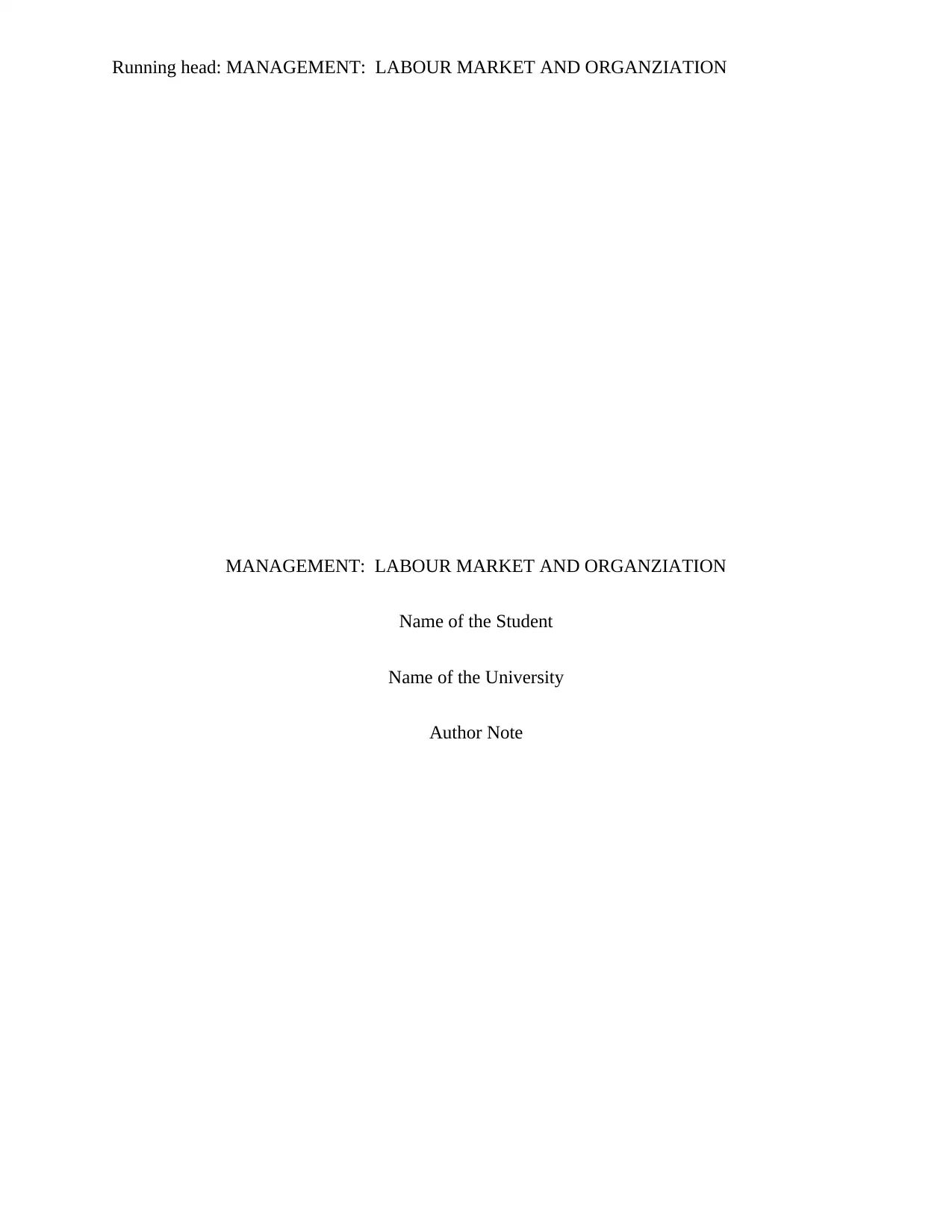
Running head: MANAGEMENT: LABOUR MARKET AND ORGANZIATION
MANAGEMENT: LABOUR MARKET AND ORGANZIATION
Name of the Student
Name of the University
Author Note
MANAGEMENT: LABOUR MARKET AND ORGANZIATION
Name of the Student
Name of the University
Author Note
Paraphrase This Document
Need a fresh take? Get an instant paraphrase of this document with our AI Paraphraser
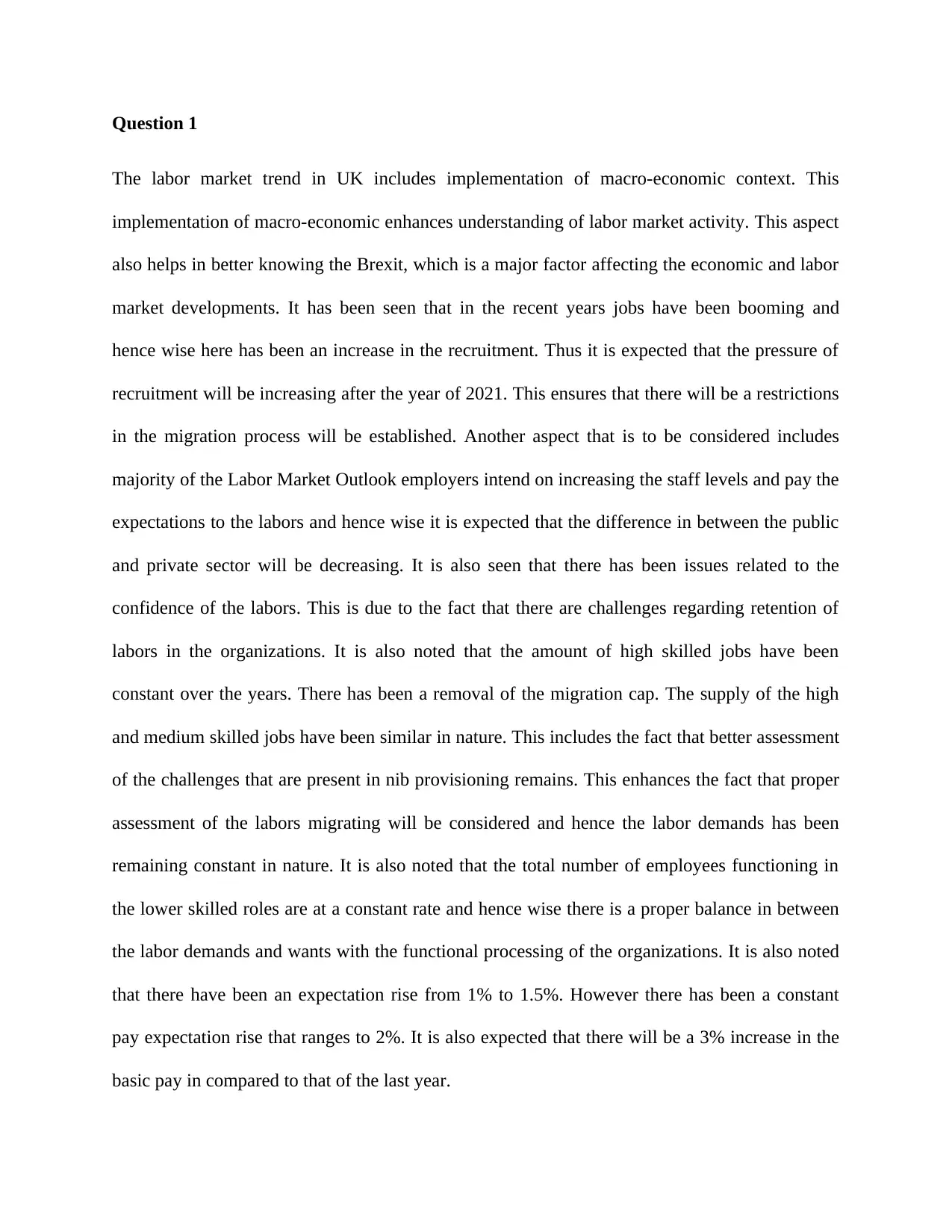
Question 1
The labor market trend in UK includes implementation of macro-economic context. This
implementation of macro-economic enhances understanding of labor market activity. This aspect
also helps in better knowing the Brexit, which is a major factor affecting the economic and labor
market developments. It has been seen that in the recent years jobs have been booming and
hence wise here has been an increase in the recruitment. Thus it is expected that the pressure of
recruitment will be increasing after the year of 2021. This ensures that there will be a restrictions
in the migration process will be established. Another aspect that is to be considered includes
majority of the Labor Market Outlook employers intend on increasing the staff levels and pay the
expectations to the labors and hence wise it is expected that the difference in between the public
and private sector will be decreasing. It is also seen that there has been issues related to the
confidence of the labors. This is due to the fact that there are challenges regarding retention of
labors in the organizations. It is also noted that the amount of high skilled jobs have been
constant over the years. There has been a removal of the migration cap. The supply of the high
and medium skilled jobs have been similar in nature. This includes the fact that better assessment
of the challenges that are present in nib provisioning remains. This enhances the fact that proper
assessment of the labors migrating will be considered and hence the labor demands has been
remaining constant in nature. It is also noted that the total number of employees functioning in
the lower skilled roles are at a constant rate and hence wise there is a proper balance in between
the labor demands and wants with the functional processing of the organizations. It is also noted
that there have been an expectation rise from 1% to 1.5%. However there has been a constant
pay expectation rise that ranges to 2%. It is also expected that there will be a 3% increase in the
basic pay in compared to that of the last year.
The labor market trend in UK includes implementation of macro-economic context. This
implementation of macro-economic enhances understanding of labor market activity. This aspect
also helps in better knowing the Brexit, which is a major factor affecting the economic and labor
market developments. It has been seen that in the recent years jobs have been booming and
hence wise here has been an increase in the recruitment. Thus it is expected that the pressure of
recruitment will be increasing after the year of 2021. This ensures that there will be a restrictions
in the migration process will be established. Another aspect that is to be considered includes
majority of the Labor Market Outlook employers intend on increasing the staff levels and pay the
expectations to the labors and hence wise it is expected that the difference in between the public
and private sector will be decreasing. It is also seen that there has been issues related to the
confidence of the labors. This is due to the fact that there are challenges regarding retention of
labors in the organizations. It is also noted that the amount of high skilled jobs have been
constant over the years. There has been a removal of the migration cap. The supply of the high
and medium skilled jobs have been similar in nature. This includes the fact that better assessment
of the challenges that are present in nib provisioning remains. This enhances the fact that proper
assessment of the labors migrating will be considered and hence the labor demands has been
remaining constant in nature. It is also noted that the total number of employees functioning in
the lower skilled roles are at a constant rate and hence wise there is a proper balance in between
the labor demands and wants with the functional processing of the organizations. It is also noted
that there have been an expectation rise from 1% to 1.5%. However there has been a constant
pay expectation rise that ranges to 2%. It is also expected that there will be a 3% increase in the
basic pay in compared to that of the last year.
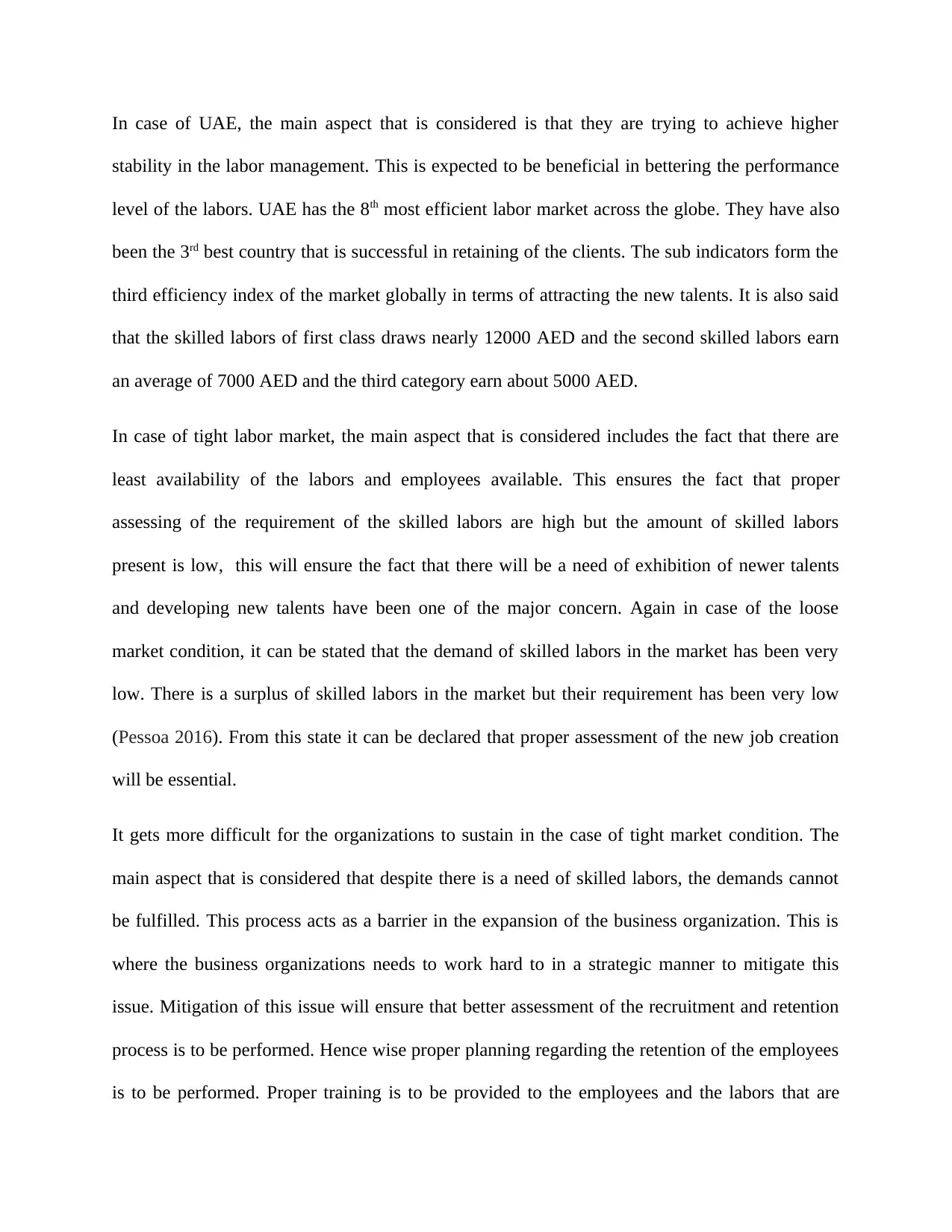
In case of UAE, the main aspect that is considered is that they are trying to achieve higher
stability in the labor management. This is expected to be beneficial in bettering the performance
level of the labors. UAE has the 8th most efficient labor market across the globe. They have also
been the 3rd best country that is successful in retaining of the clients. The sub indicators form the
third efficiency index of the market globally in terms of attracting the new talents. It is also said
that the skilled labors of first class draws nearly 12000 AED and the second skilled labors earn
an average of 7000 AED and the third category earn about 5000 AED.
In case of tight labor market, the main aspect that is considered includes the fact that there are
least availability of the labors and employees available. This ensures the fact that proper
assessing of the requirement of the skilled labors are high but the amount of skilled labors
present is low, this will ensure the fact that there will be a need of exhibition of newer talents
and developing new talents have been one of the major concern. Again in case of the loose
market condition, it can be stated that the demand of skilled labors in the market has been very
low. There is a surplus of skilled labors in the market but their requirement has been very low
(Pessoa 2016). From this state it can be declared that proper assessment of the new job creation
will be essential.
It gets more difficult for the organizations to sustain in the case of tight market condition. The
main aspect that is considered that despite there is a need of skilled labors, the demands cannot
be fulfilled. This process acts as a barrier in the expansion of the business organization. This is
where the business organizations needs to work hard to in a strategic manner to mitigate this
issue. Mitigation of this issue will ensure that better assessment of the recruitment and retention
process is to be performed. Hence wise proper planning regarding the retention of the employees
is to be performed. Proper training is to be provided to the employees and the labors that are
stability in the labor management. This is expected to be beneficial in bettering the performance
level of the labors. UAE has the 8th most efficient labor market across the globe. They have also
been the 3rd best country that is successful in retaining of the clients. The sub indicators form the
third efficiency index of the market globally in terms of attracting the new talents. It is also said
that the skilled labors of first class draws nearly 12000 AED and the second skilled labors earn
an average of 7000 AED and the third category earn about 5000 AED.
In case of tight labor market, the main aspect that is considered includes the fact that there are
least availability of the labors and employees available. This ensures the fact that proper
assessing of the requirement of the skilled labors are high but the amount of skilled labors
present is low, this will ensure the fact that there will be a need of exhibition of newer talents
and developing new talents have been one of the major concern. Again in case of the loose
market condition, it can be stated that the demand of skilled labors in the market has been very
low. There is a surplus of skilled labors in the market but their requirement has been very low
(Pessoa 2016). From this state it can be declared that proper assessment of the new job creation
will be essential.
It gets more difficult for the organizations to sustain in the case of tight market condition. The
main aspect that is considered that despite there is a need of skilled labors, the demands cannot
be fulfilled. This process acts as a barrier in the expansion of the business organization. This is
where the business organizations needs to work hard to in a strategic manner to mitigate this
issue. Mitigation of this issue will ensure that better assessment of the recruitment and retention
process is to be performed. Hence wise proper planning regarding the retention of the employees
is to be performed. Proper training is to be provided to the employees and the labors that are
⊘ This is a preview!⊘
Do you want full access?
Subscribe today to unlock all pages.

Trusted by 1+ million students worldwide
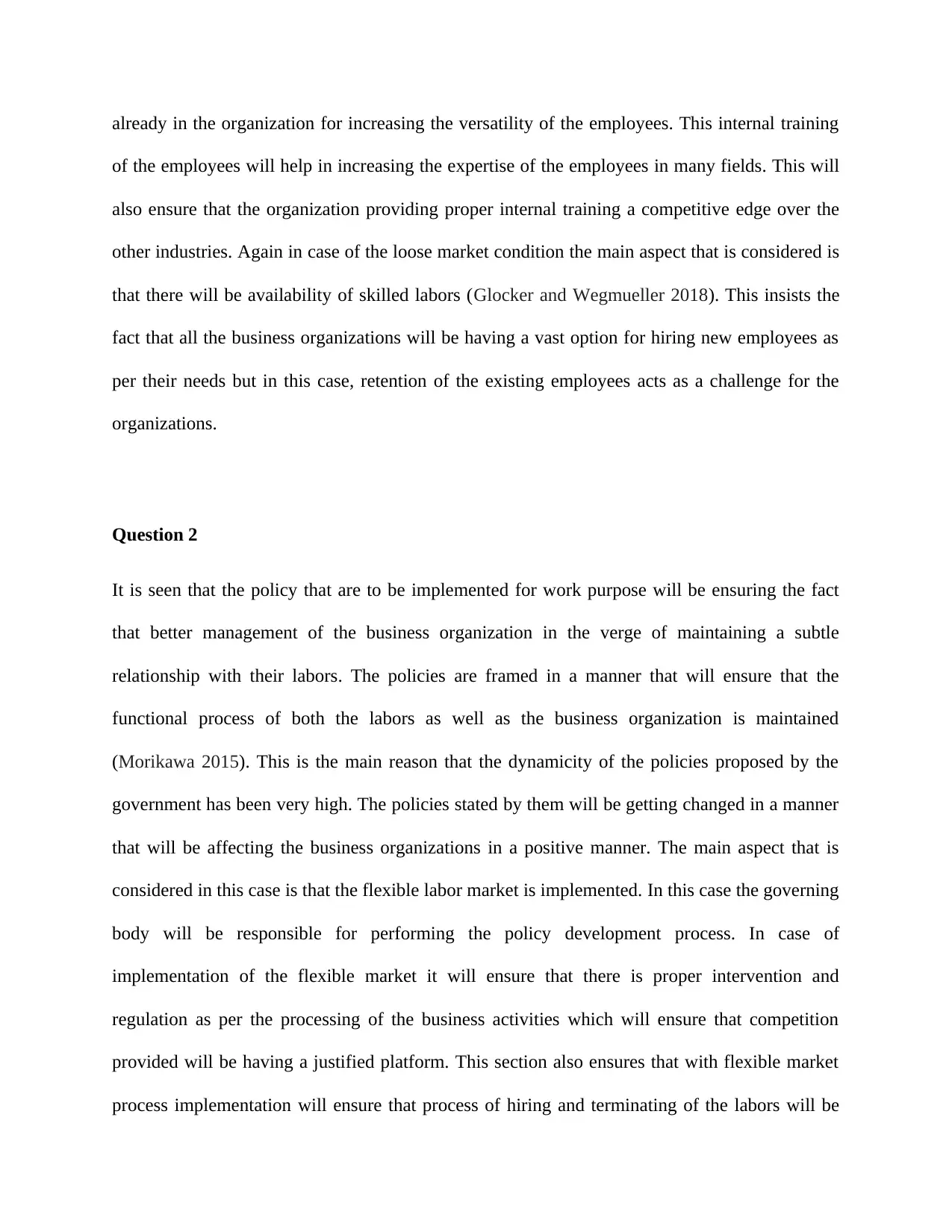
already in the organization for increasing the versatility of the employees. This internal training
of the employees will help in increasing the expertise of the employees in many fields. This will
also ensure that the organization providing proper internal training a competitive edge over the
other industries. Again in case of the loose market condition the main aspect that is considered is
that there will be availability of skilled labors (Glocker and Wegmueller 2018). This insists the
fact that all the business organizations will be having a vast option for hiring new employees as
per their needs but in this case, retention of the existing employees acts as a challenge for the
organizations.
Question 2
It is seen that the policy that are to be implemented for work purpose will be ensuring the fact
that better management of the business organization in the verge of maintaining a subtle
relationship with their labors. The policies are framed in a manner that will ensure that the
functional process of both the labors as well as the business organization is maintained
(Morikawa 2015). This is the main reason that the dynamicity of the policies proposed by the
government has been very high. The policies stated by them will be getting changed in a manner
that will be affecting the business organizations in a positive manner. The main aspect that is
considered in this case is that the flexible labor market is implemented. In this case the governing
body will be responsible for performing the policy development process. In case of
implementation of the flexible market it will ensure that there is proper intervention and
regulation as per the processing of the business activities which will ensure that competition
provided will be having a justified platform. This section also ensures that with flexible market
process implementation will ensure that process of hiring and terminating of the labors will be
of the employees will help in increasing the expertise of the employees in many fields. This will
also ensure that the organization providing proper internal training a competitive edge over the
other industries. Again in case of the loose market condition the main aspect that is considered is
that there will be availability of skilled labors (Glocker and Wegmueller 2018). This insists the
fact that all the business organizations will be having a vast option for hiring new employees as
per their needs but in this case, retention of the existing employees acts as a challenge for the
organizations.
Question 2
It is seen that the policy that are to be implemented for work purpose will be ensuring the fact
that better management of the business organization in the verge of maintaining a subtle
relationship with their labors. The policies are framed in a manner that will ensure that the
functional process of both the labors as well as the business organization is maintained
(Morikawa 2015). This is the main reason that the dynamicity of the policies proposed by the
government has been very high. The policies stated by them will be getting changed in a manner
that will be affecting the business organizations in a positive manner. The main aspect that is
considered in this case is that the flexible labor market is implemented. In this case the governing
body will be responsible for performing the policy development process. In case of
implementation of the flexible market it will ensure that there is proper intervention and
regulation as per the processing of the business activities which will ensure that competition
provided will be having a justified platform. This section also ensures that with flexible market
process implementation will ensure that process of hiring and terminating of the labors will be
Paraphrase This Document
Need a fresh take? Get an instant paraphrase of this document with our AI Paraphraser
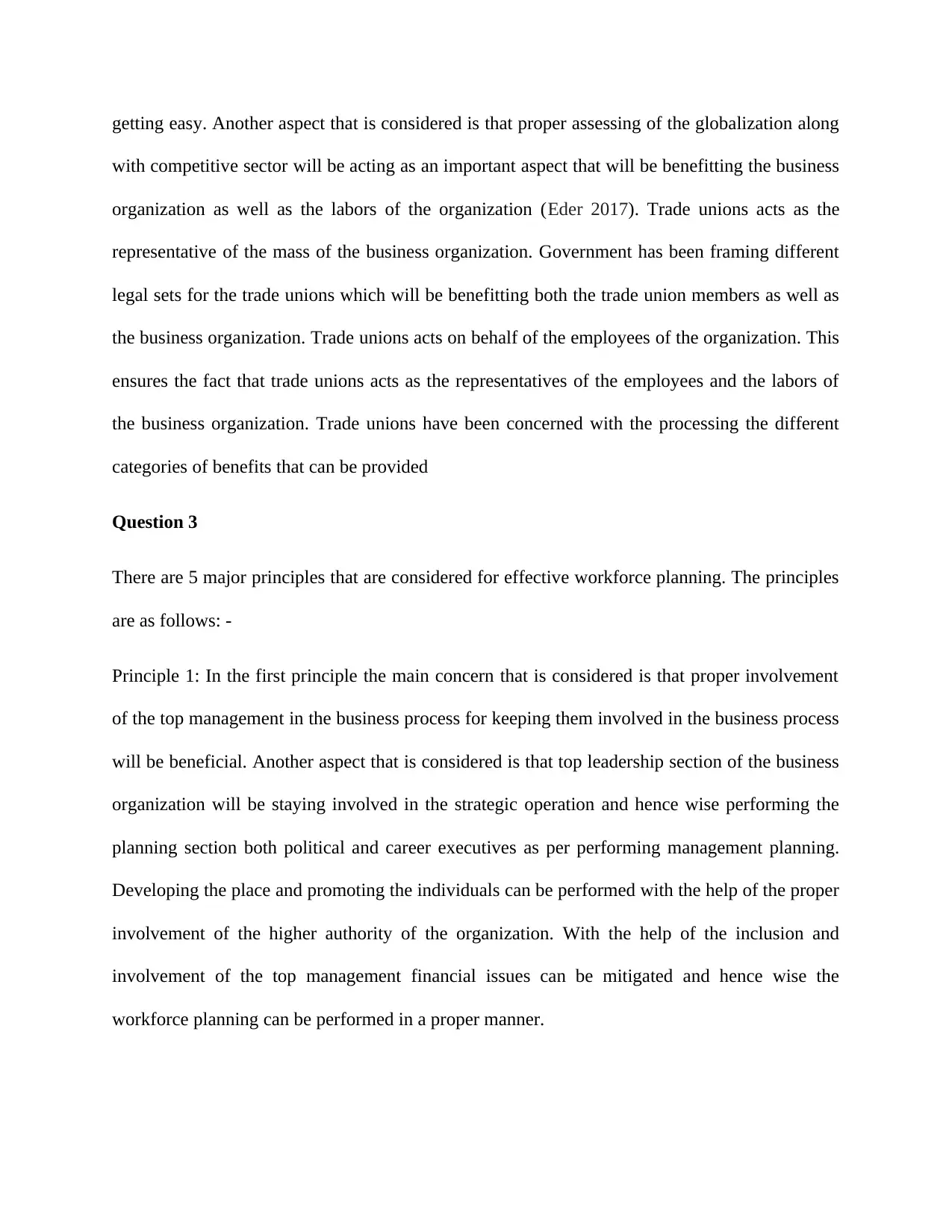
getting easy. Another aspect that is considered is that proper assessing of the globalization along
with competitive sector will be acting as an important aspect that will be benefitting the business
organization as well as the labors of the organization (Eder 2017). Trade unions acts as the
representative of the mass of the business organization. Government has been framing different
legal sets for the trade unions which will be benefitting both the trade union members as well as
the business organization. Trade unions acts on behalf of the employees of the organization. This
ensures the fact that trade unions acts as the representatives of the employees and the labors of
the business organization. Trade unions have been concerned with the processing the different
categories of benefits that can be provided
Question 3
There are 5 major principles that are considered for effective workforce planning. The principles
are as follows: -
Principle 1: In the first principle the main concern that is considered is that proper involvement
of the top management in the business process for keeping them involved in the business process
will be beneficial. Another aspect that is considered is that top leadership section of the business
organization will be staying involved in the strategic operation and hence wise performing the
planning section both political and career executives as per performing management planning.
Developing the place and promoting the individuals can be performed with the help of the proper
involvement of the higher authority of the organization. With the help of the inclusion and
involvement of the top management financial issues can be mitigated and hence wise the
workforce planning can be performed in a proper manner.
with competitive sector will be acting as an important aspect that will be benefitting the business
organization as well as the labors of the organization (Eder 2017). Trade unions acts as the
representative of the mass of the business organization. Government has been framing different
legal sets for the trade unions which will be benefitting both the trade union members as well as
the business organization. Trade unions acts on behalf of the employees of the organization. This
ensures the fact that trade unions acts as the representatives of the employees and the labors of
the business organization. Trade unions have been concerned with the processing the different
categories of benefits that can be provided
Question 3
There are 5 major principles that are considered for effective workforce planning. The principles
are as follows: -
Principle 1: In the first principle the main concern that is considered is that proper involvement
of the top management in the business process for keeping them involved in the business process
will be beneficial. Another aspect that is considered is that top leadership section of the business
organization will be staying involved in the strategic operation and hence wise performing the
planning section both political and career executives as per performing management planning.
Developing the place and promoting the individuals can be performed with the help of the proper
involvement of the higher authority of the organization. With the help of the inclusion and
involvement of the top management financial issues can be mitigated and hence wise the
workforce planning can be performed in a proper manner.
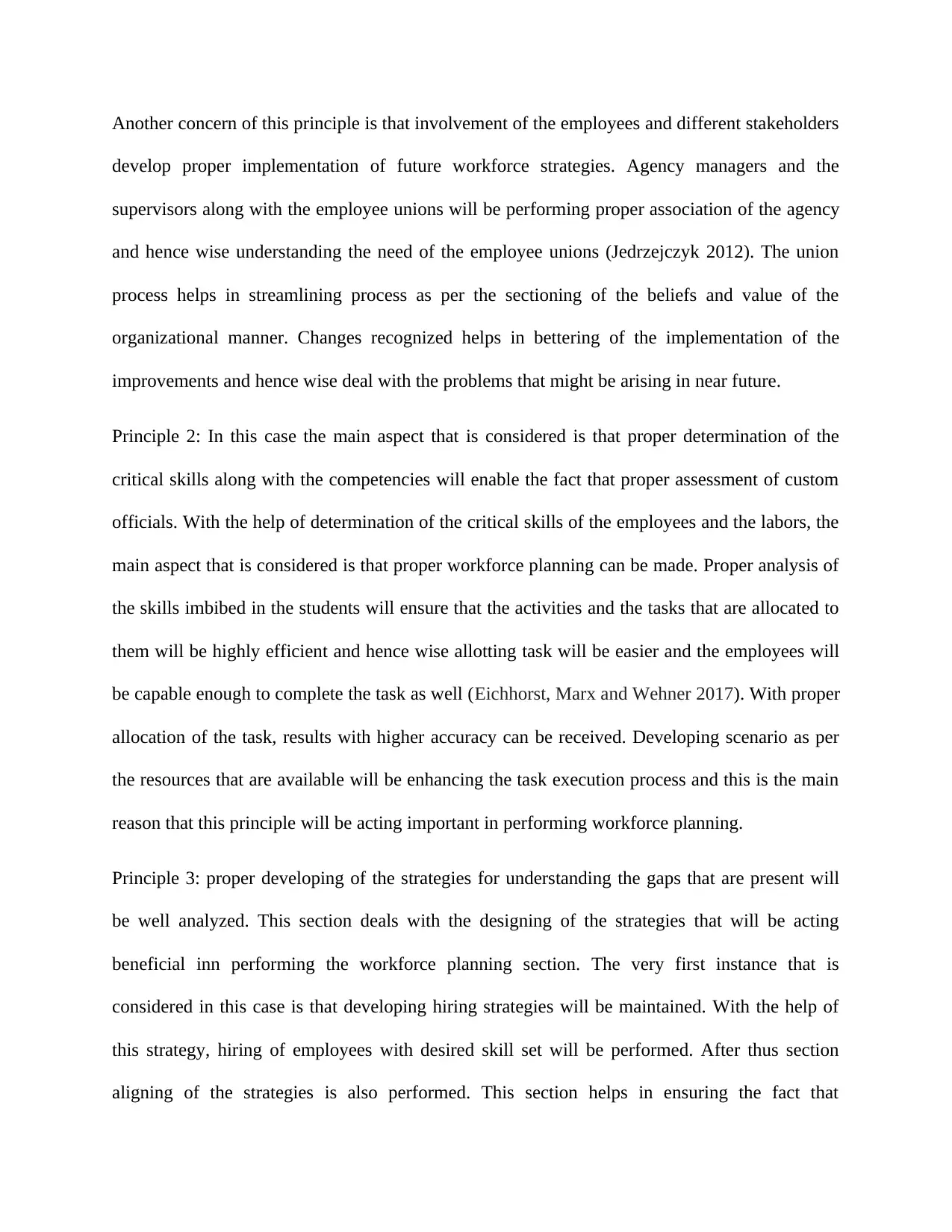
Another concern of this principle is that involvement of the employees and different stakeholders
develop proper implementation of future workforce strategies. Agency managers and the
supervisors along with the employee unions will be performing proper association of the agency
and hence wise understanding the need of the employee unions (Jedrzejczyk 2012). The union
process helps in streamlining process as per the sectioning of the beliefs and value of the
organizational manner. Changes recognized helps in bettering of the implementation of the
improvements and hence wise deal with the problems that might be arising in near future.
Principle 2: In this case the main aspect that is considered is that proper determination of the
critical skills along with the competencies will enable the fact that proper assessment of custom
officials. With the help of determination of the critical skills of the employees and the labors, the
main aspect that is considered is that proper workforce planning can be made. Proper analysis of
the skills imbibed in the students will ensure that the activities and the tasks that are allocated to
them will be highly efficient and hence wise allotting task will be easier and the employees will
be capable enough to complete the task as well (Eichhorst, Marx and Wehner 2017). With proper
allocation of the task, results with higher accuracy can be received. Developing scenario as per
the resources that are available will be enhancing the task execution process and this is the main
reason that this principle will be acting important in performing workforce planning.
Principle 3: proper developing of the strategies for understanding the gaps that are present will
be well analyzed. This section deals with the designing of the strategies that will be acting
beneficial inn performing the workforce planning section. The very first instance that is
considered in this case is that developing hiring strategies will be maintained. With the help of
this strategy, hiring of employees with desired skill set will be performed. After thus section
aligning of the strategies is also performed. This section helps in ensuring the fact that
develop proper implementation of future workforce strategies. Agency managers and the
supervisors along with the employee unions will be performing proper association of the agency
and hence wise understanding the need of the employee unions (Jedrzejczyk 2012). The union
process helps in streamlining process as per the sectioning of the beliefs and value of the
organizational manner. Changes recognized helps in bettering of the implementation of the
improvements and hence wise deal with the problems that might be arising in near future.
Principle 2: In this case the main aspect that is considered is that proper determination of the
critical skills along with the competencies will enable the fact that proper assessment of custom
officials. With the help of determination of the critical skills of the employees and the labors, the
main aspect that is considered is that proper workforce planning can be made. Proper analysis of
the skills imbibed in the students will ensure that the activities and the tasks that are allocated to
them will be highly efficient and hence wise allotting task will be easier and the employees will
be capable enough to complete the task as well (Eichhorst, Marx and Wehner 2017). With proper
allocation of the task, results with higher accuracy can be received. Developing scenario as per
the resources that are available will be enhancing the task execution process and this is the main
reason that this principle will be acting important in performing workforce planning.
Principle 3: proper developing of the strategies for understanding the gaps that are present will
be well analyzed. This section deals with the designing of the strategies that will be acting
beneficial inn performing the workforce planning section. The very first instance that is
considered in this case is that developing hiring strategies will be maintained. With the help of
this strategy, hiring of employees with desired skill set will be performed. After thus section
aligning of the strategies is also performed. This section helps in ensuring the fact that
⊘ This is a preview!⊘
Do you want full access?
Subscribe today to unlock all pages.

Trusted by 1+ million students worldwide
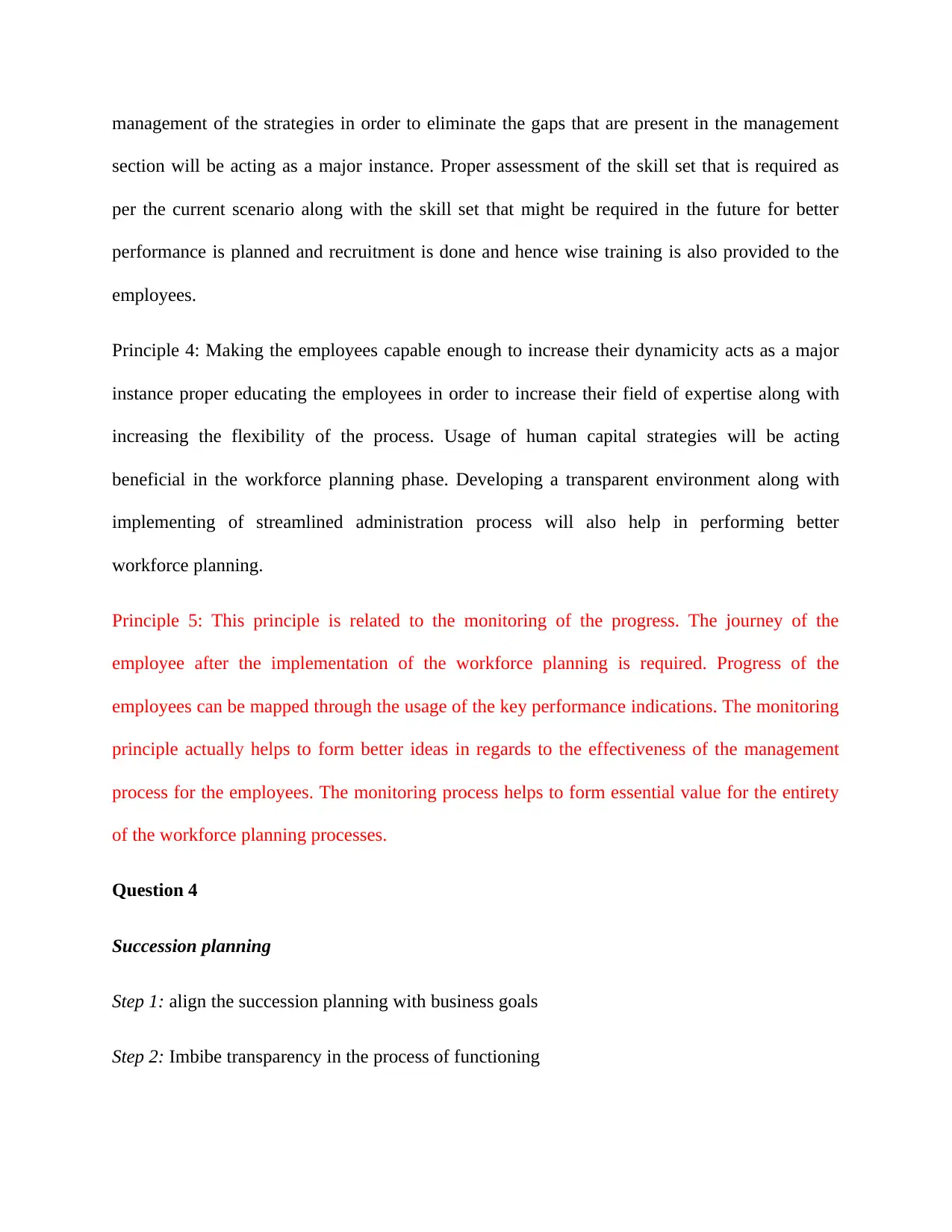
management of the strategies in order to eliminate the gaps that are present in the management
section will be acting as a major instance. Proper assessment of the skill set that is required as
per the current scenario along with the skill set that might be required in the future for better
performance is planned and recruitment is done and hence wise training is also provided to the
employees.
Principle 4: Making the employees capable enough to increase their dynamicity acts as a major
instance proper educating the employees in order to increase their field of expertise along with
increasing the flexibility of the process. Usage of human capital strategies will be acting
beneficial in the workforce planning phase. Developing a transparent environment along with
implementing of streamlined administration process will also help in performing better
workforce planning.
Principle 5: This principle is related to the monitoring of the progress. The journey of the
employee after the implementation of the workforce planning is required. Progress of the
employees can be mapped through the usage of the key performance indications. The monitoring
principle actually helps to form better ideas in regards to the effectiveness of the management
process for the employees. The monitoring process helps to form essential value for the entirety
of the workforce planning processes.
Question 4
Succession planning
Step 1: align the succession planning with business goals
Step 2: Imbibe transparency in the process of functioning
section will be acting as a major instance. Proper assessment of the skill set that is required as
per the current scenario along with the skill set that might be required in the future for better
performance is planned and recruitment is done and hence wise training is also provided to the
employees.
Principle 4: Making the employees capable enough to increase their dynamicity acts as a major
instance proper educating the employees in order to increase their field of expertise along with
increasing the flexibility of the process. Usage of human capital strategies will be acting
beneficial in the workforce planning phase. Developing a transparent environment along with
implementing of streamlined administration process will also help in performing better
workforce planning.
Principle 5: This principle is related to the monitoring of the progress. The journey of the
employee after the implementation of the workforce planning is required. Progress of the
employees can be mapped through the usage of the key performance indications. The monitoring
principle actually helps to form better ideas in regards to the effectiveness of the management
process for the employees. The monitoring process helps to form essential value for the entirety
of the workforce planning processes.
Question 4
Succession planning
Step 1: align the succession planning with business goals
Step 2: Imbibe transparency in the process of functioning
Paraphrase This Document
Need a fresh take? Get an instant paraphrase of this document with our AI Paraphraser
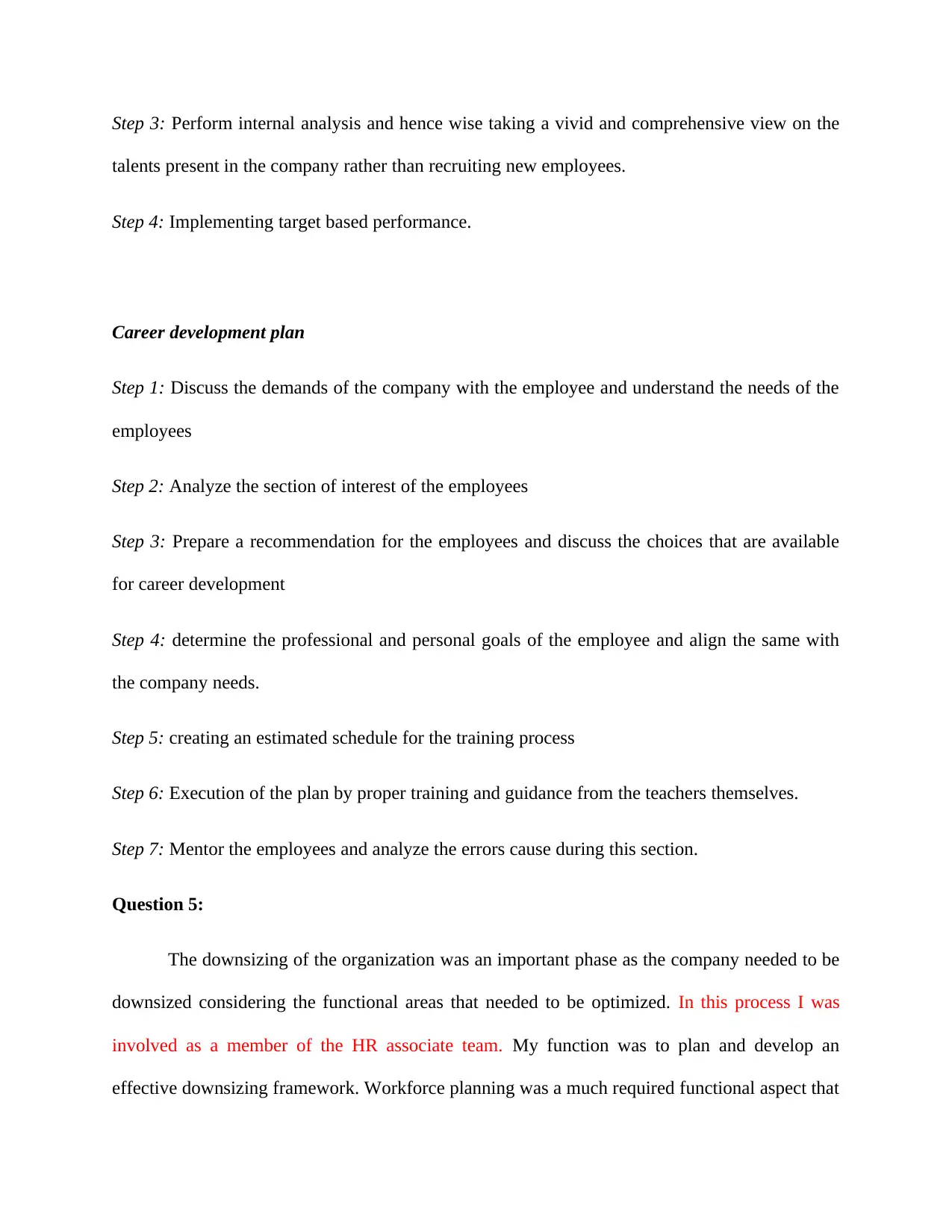
Step 3: Perform internal analysis and hence wise taking a vivid and comprehensive view on the
talents present in the company rather than recruiting new employees.
Step 4: Implementing target based performance.
Career development plan
Step 1: Discuss the demands of the company with the employee and understand the needs of the
employees
Step 2: Analyze the section of interest of the employees
Step 3: Prepare a recommendation for the employees and discuss the choices that are available
for career development
Step 4: determine the professional and personal goals of the employee and align the same with
the company needs.
Step 5: creating an estimated schedule for the training process
Step 6: Execution of the plan by proper training and guidance from the teachers themselves.
Step 7: Mentor the employees and analyze the errors cause during this section.
Question 5:
The downsizing of the organization was an important phase as the company needed to be
downsized considering the functional areas that needed to be optimized. In this process I was
involved as a member of the HR associate team. My function was to plan and develop an
effective downsizing framework. Workforce planning was a much required functional aspect that
talents present in the company rather than recruiting new employees.
Step 4: Implementing target based performance.
Career development plan
Step 1: Discuss the demands of the company with the employee and understand the needs of the
employees
Step 2: Analyze the section of interest of the employees
Step 3: Prepare a recommendation for the employees and discuss the choices that are available
for career development
Step 4: determine the professional and personal goals of the employee and align the same with
the company needs.
Step 5: creating an estimated schedule for the training process
Step 6: Execution of the plan by proper training and guidance from the teachers themselves.
Step 7: Mentor the employees and analyze the errors cause during this section.
Question 5:
The downsizing of the organization was an important phase as the company needed to be
downsized considering the functional areas that needed to be optimized. In this process I was
involved as a member of the HR associate team. My function was to plan and develop an
effective downsizing framework. Workforce planning was a much required functional aspect that
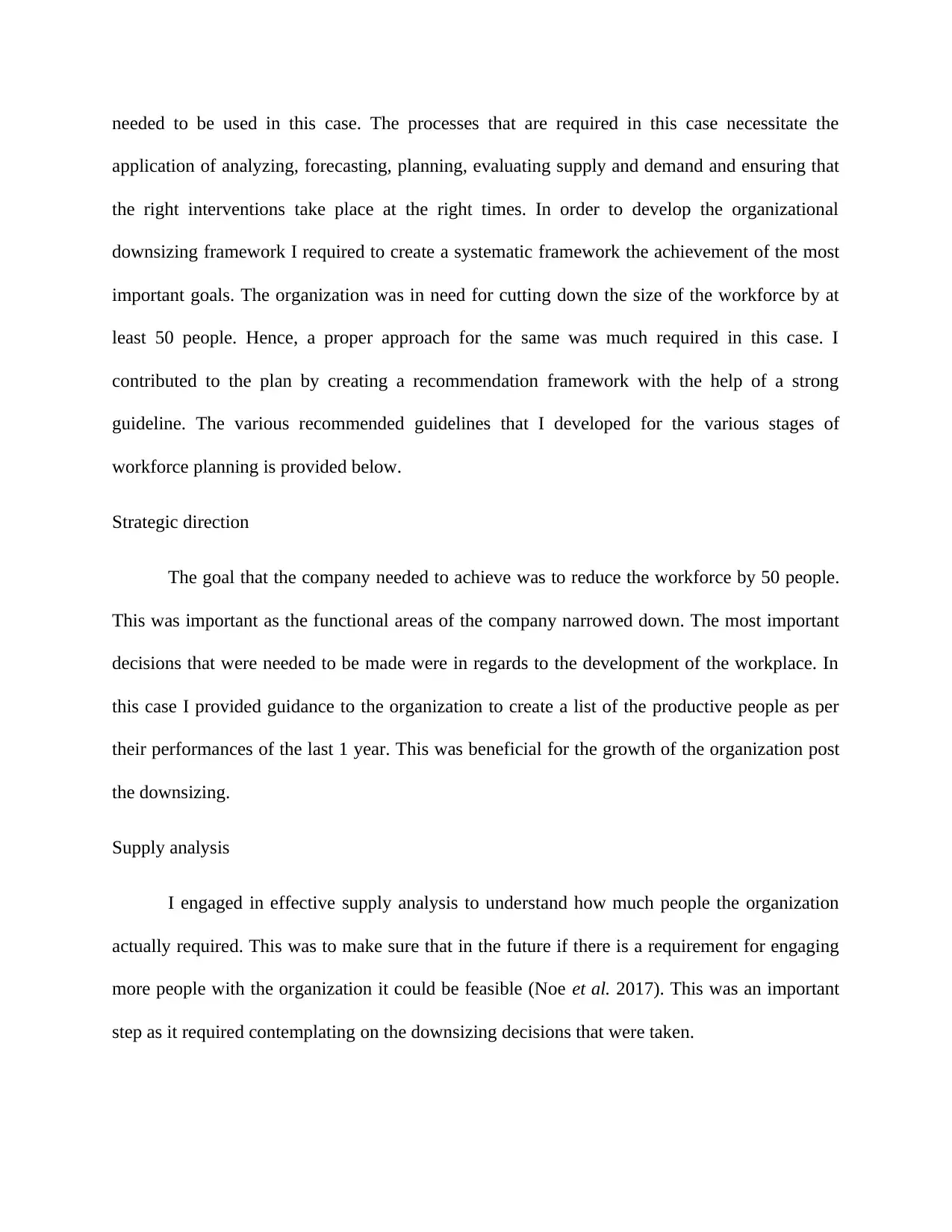
needed to be used in this case. The processes that are required in this case necessitate the
application of analyzing, forecasting, planning, evaluating supply and demand and ensuring that
the right interventions take place at the right times. In order to develop the organizational
downsizing framework I required to create a systematic framework the achievement of the most
important goals. The organization was in need for cutting down the size of the workforce by at
least 50 people. Hence, a proper approach for the same was much required in this case. I
contributed to the plan by creating a recommendation framework with the help of a strong
guideline. The various recommended guidelines that I developed for the various stages of
workforce planning is provided below.
Strategic direction
The goal that the company needed to achieve was to reduce the workforce by 50 people.
This was important as the functional areas of the company narrowed down. The most important
decisions that were needed to be made were in regards to the development of the workplace. In
this case I provided guidance to the organization to create a list of the productive people as per
their performances of the last 1 year. This was beneficial for the growth of the organization post
the downsizing.
Supply analysis
I engaged in effective supply analysis to understand how much people the organization
actually required. This was to make sure that in the future if there is a requirement for engaging
more people with the organization it could be feasible (Noe et al. 2017). This was an important
step as it required contemplating on the downsizing decisions that were taken.
application of analyzing, forecasting, planning, evaluating supply and demand and ensuring that
the right interventions take place at the right times. In order to develop the organizational
downsizing framework I required to create a systematic framework the achievement of the most
important goals. The organization was in need for cutting down the size of the workforce by at
least 50 people. Hence, a proper approach for the same was much required in this case. I
contributed to the plan by creating a recommendation framework with the help of a strong
guideline. The various recommended guidelines that I developed for the various stages of
workforce planning is provided below.
Strategic direction
The goal that the company needed to achieve was to reduce the workforce by 50 people.
This was important as the functional areas of the company narrowed down. The most important
decisions that were needed to be made were in regards to the development of the workplace. In
this case I provided guidance to the organization to create a list of the productive people as per
their performances of the last 1 year. This was beneficial for the growth of the organization post
the downsizing.
Supply analysis
I engaged in effective supply analysis to understand how much people the organization
actually required. This was to make sure that in the future if there is a requirement for engaging
more people with the organization it could be feasible (Noe et al. 2017). This was an important
step as it required contemplating on the downsizing decisions that were taken.
⊘ This is a preview!⊘
Do you want full access?
Subscribe today to unlock all pages.

Trusted by 1+ million students worldwide
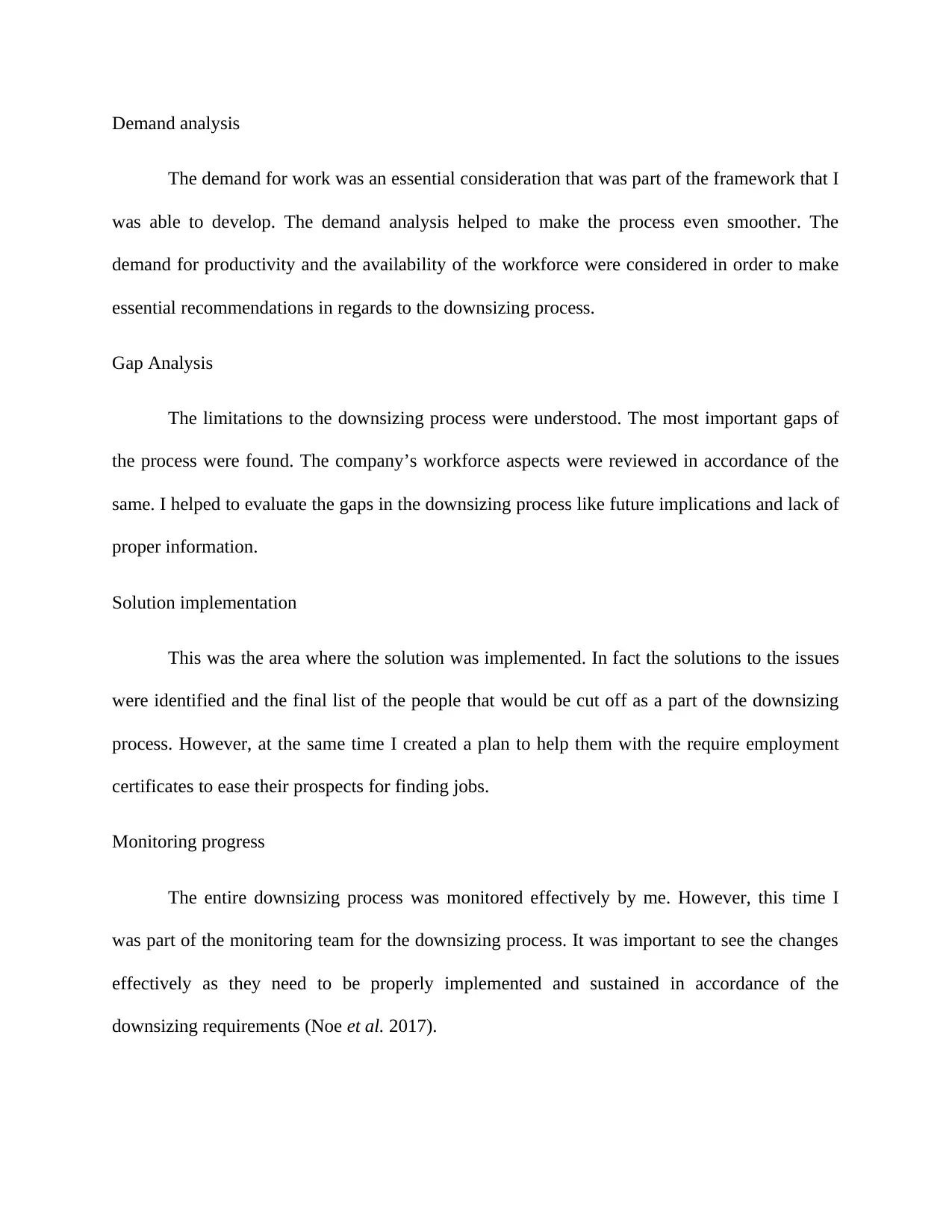
Demand analysis
The demand for work was an essential consideration that was part of the framework that I
was able to develop. The demand analysis helped to make the process even smoother. The
demand for productivity and the availability of the workforce were considered in order to make
essential recommendations in regards to the downsizing process.
Gap Analysis
The limitations to the downsizing process were understood. The most important gaps of
the process were found. The company’s workforce aspects were reviewed in accordance of the
same. I helped to evaluate the gaps in the downsizing process like future implications and lack of
proper information.
Solution implementation
This was the area where the solution was implemented. In fact the solutions to the issues
were identified and the final list of the people that would be cut off as a part of the downsizing
process. However, at the same time I created a plan to help them with the require employment
certificates to ease their prospects for finding jobs.
Monitoring progress
The entire downsizing process was monitored effectively by me. However, this time I
was part of the monitoring team for the downsizing process. It was important to see the changes
effectively as they need to be properly implemented and sustained in accordance of the
downsizing requirements (Noe et al. 2017).
The demand for work was an essential consideration that was part of the framework that I
was able to develop. The demand analysis helped to make the process even smoother. The
demand for productivity and the availability of the workforce were considered in order to make
essential recommendations in regards to the downsizing process.
Gap Analysis
The limitations to the downsizing process were understood. The most important gaps of
the process were found. The company’s workforce aspects were reviewed in accordance of the
same. I helped to evaluate the gaps in the downsizing process like future implications and lack of
proper information.
Solution implementation
This was the area where the solution was implemented. In fact the solutions to the issues
were identified and the final list of the people that would be cut off as a part of the downsizing
process. However, at the same time I created a plan to help them with the require employment
certificates to ease their prospects for finding jobs.
Monitoring progress
The entire downsizing process was monitored effectively by me. However, this time I
was part of the monitoring team for the downsizing process. It was important to see the changes
effectively as they need to be properly implemented and sustained in accordance of the
downsizing requirements (Noe et al. 2017).
Paraphrase This Document
Need a fresh take? Get an instant paraphrase of this document with our AI Paraphraser
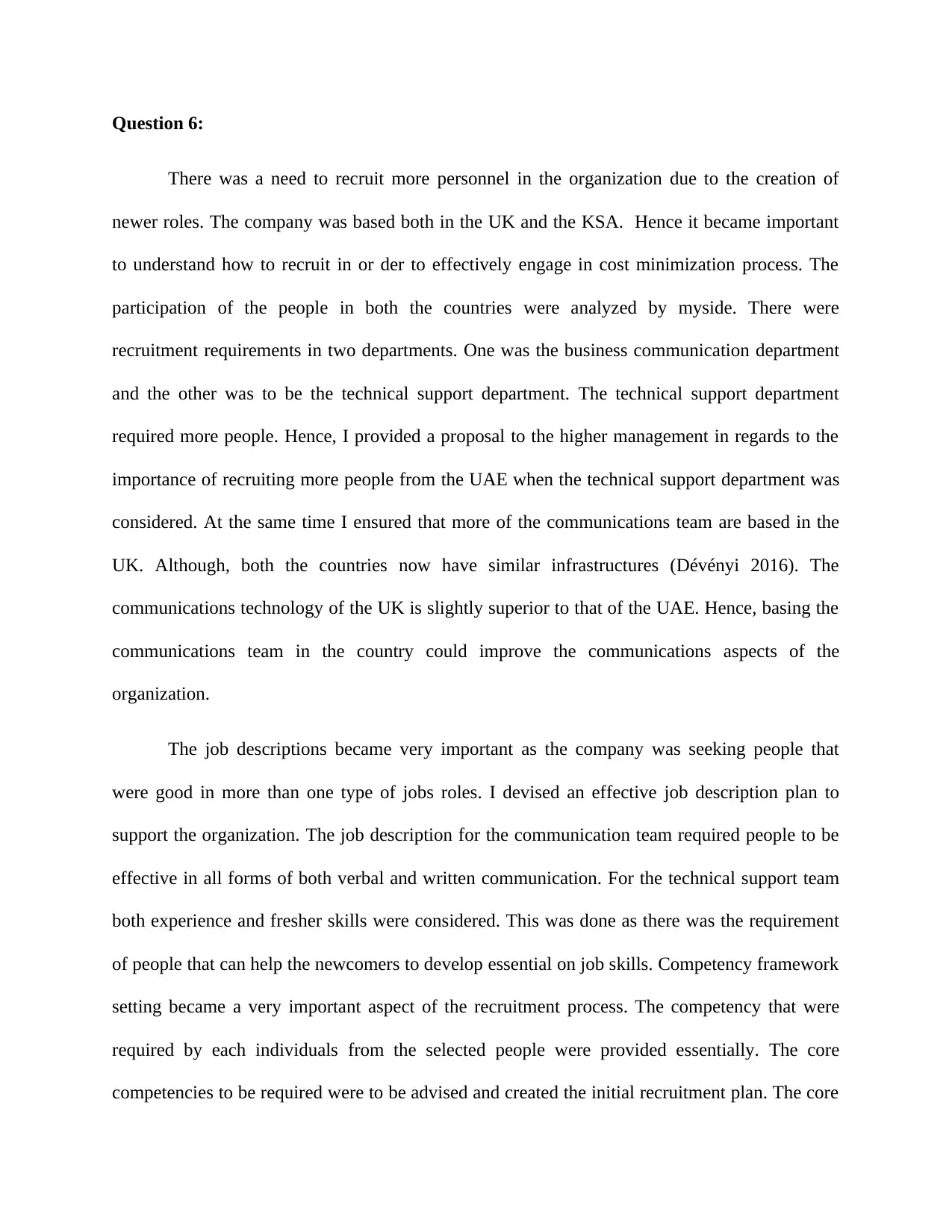
Question 6:
There was a need to recruit more personnel in the organization due to the creation of
newer roles. The company was based both in the UK and the KSA. Hence it became important
to understand how to recruit in or der to effectively engage in cost minimization process. The
participation of the people in both the countries were analyzed by myside. There were
recruitment requirements in two departments. One was the business communication department
and the other was to be the technical support department. The technical support department
required more people. Hence, I provided a proposal to the higher management in regards to the
importance of recruiting more people from the UAE when the technical support department was
considered. At the same time I ensured that more of the communications team are based in the
UK. Although, both the countries now have similar infrastructures (Dévényi 2016). The
communications technology of the UK is slightly superior to that of the UAE. Hence, basing the
communications team in the country could improve the communications aspects of the
organization.
The job descriptions became very important as the company was seeking people that
were good in more than one type of jobs roles. I devised an effective job description plan to
support the organization. The job description for the communication team required people to be
effective in all forms of both verbal and written communication. For the technical support team
both experience and fresher skills were considered. This was done as there was the requirement
of people that can help the newcomers to develop essential on job skills. Competency framework
setting became a very important aspect of the recruitment process. The competency that were
required by each individuals from the selected people were provided essentially. The core
competencies to be required were to be advised and created the initial recruitment plan. The core
There was a need to recruit more personnel in the organization due to the creation of
newer roles. The company was based both in the UK and the KSA. Hence it became important
to understand how to recruit in or der to effectively engage in cost minimization process. The
participation of the people in both the countries were analyzed by myside. There were
recruitment requirements in two departments. One was the business communication department
and the other was to be the technical support department. The technical support department
required more people. Hence, I provided a proposal to the higher management in regards to the
importance of recruiting more people from the UAE when the technical support department was
considered. At the same time I ensured that more of the communications team are based in the
UK. Although, both the countries now have similar infrastructures (Dévényi 2016). The
communications technology of the UK is slightly superior to that of the UAE. Hence, basing the
communications team in the country could improve the communications aspects of the
organization.
The job descriptions became very important as the company was seeking people that
were good in more than one type of jobs roles. I devised an effective job description plan to
support the organization. The job description for the communication team required people to be
effective in all forms of both verbal and written communication. For the technical support team
both experience and fresher skills were considered. This was done as there was the requirement
of people that can help the newcomers to develop essential on job skills. Competency framework
setting became a very important aspect of the recruitment process. The competency that were
required by each individuals from the selected people were provided essentially. The core
competencies to be required were to be advised and created the initial recruitment plan. The core
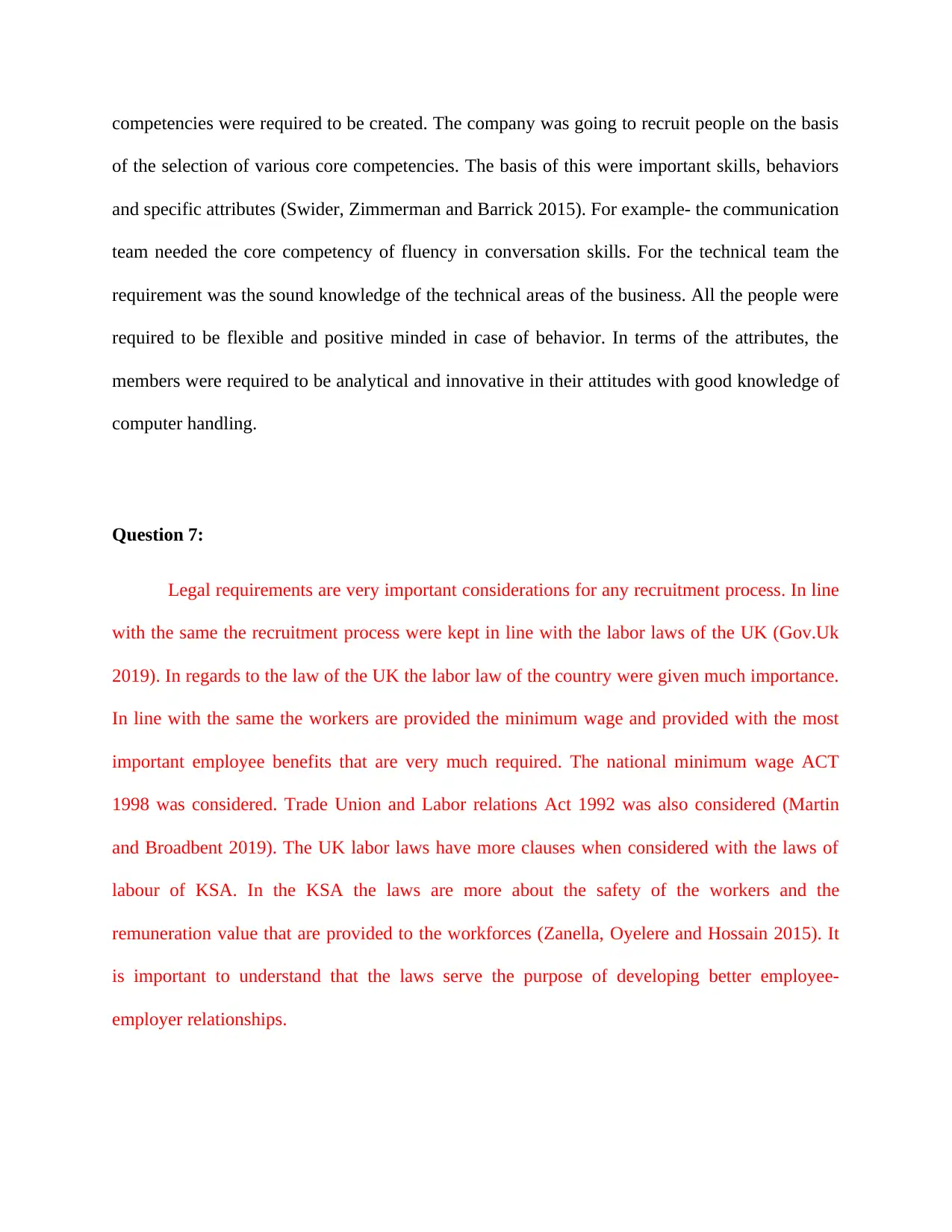
competencies were required to be created. The company was going to recruit people on the basis
of the selection of various core competencies. The basis of this were important skills, behaviors
and specific attributes (Swider, Zimmerman and Barrick 2015). For example- the communication
team needed the core competency of fluency in conversation skills. For the technical team the
requirement was the sound knowledge of the technical areas of the business. All the people were
required to be flexible and positive minded in case of behavior. In terms of the attributes, the
members were required to be analytical and innovative in their attitudes with good knowledge of
computer handling.
Question 7:
Legal requirements are very important considerations for any recruitment process. In line
with the same the recruitment process were kept in line with the labor laws of the UK (Gov.Uk
2019). In regards to the law of the UK the labor law of the country were given much importance.
In line with the same the workers are provided the minimum wage and provided with the most
important employee benefits that are very much required. The national minimum wage ACT
1998 was considered. Trade Union and Labor relations Act 1992 was also considered (Martin
and Broadbent 2019). The UK labor laws have more clauses when considered with the laws of
labour of KSA. In the KSA the laws are more about the safety of the workers and the
remuneration value that are provided to the workforces (Zanella, Oyelere and Hossain 2015). It
is important to understand that the laws serve the purpose of developing better employee-
employer relationships.
of the selection of various core competencies. The basis of this were important skills, behaviors
and specific attributes (Swider, Zimmerman and Barrick 2015). For example- the communication
team needed the core competency of fluency in conversation skills. For the technical team the
requirement was the sound knowledge of the technical areas of the business. All the people were
required to be flexible and positive minded in case of behavior. In terms of the attributes, the
members were required to be analytical and innovative in their attitudes with good knowledge of
computer handling.
Question 7:
Legal requirements are very important considerations for any recruitment process. In line
with the same the recruitment process were kept in line with the labor laws of the UK (Gov.Uk
2019). In regards to the law of the UK the labor law of the country were given much importance.
In line with the same the workers are provided the minimum wage and provided with the most
important employee benefits that are very much required. The national minimum wage ACT
1998 was considered. Trade Union and Labor relations Act 1992 was also considered (Martin
and Broadbent 2019). The UK labor laws have more clauses when considered with the laws of
labour of KSA. In the KSA the laws are more about the safety of the workers and the
remuneration value that are provided to the workforces (Zanella, Oyelere and Hossain 2015). It
is important to understand that the laws serve the purpose of developing better employee-
employer relationships.
⊘ This is a preview!⊘
Do you want full access?
Subscribe today to unlock all pages.

Trusted by 1+ million students worldwide
1 out of 18
Related Documents
Your All-in-One AI-Powered Toolkit for Academic Success.
+13062052269
info@desklib.com
Available 24*7 on WhatsApp / Email
![[object Object]](/_next/static/media/star-bottom.7253800d.svg)
Unlock your academic potential
Copyright © 2020–2025 A2Z Services. All Rights Reserved. Developed and managed by ZUCOL.





